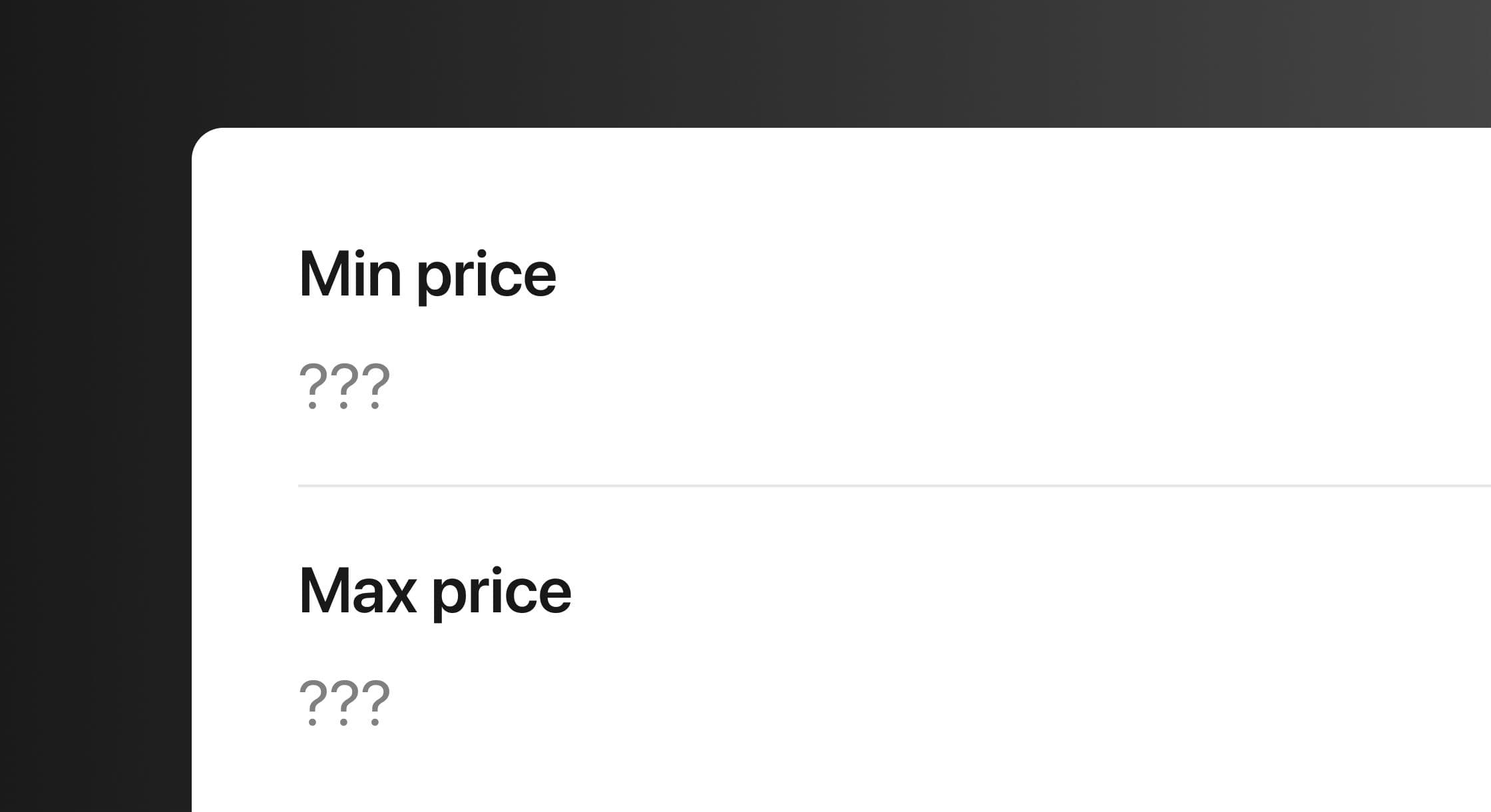/Mastering Amazon's Minimum Price: A 3rd Party Seller's Guide to Min and Max Prices

Mastering Amazon's Minimum Price: A 3rd Party Seller's Guide to Min and Max Prices
Are you tired of playing guessing games with your pricing strategy? Want to know the secret to protecting your profits while maximizing your sales?
You’re in the right place. Today, we’re diving deep into the world of Amazon Min Price and Amazon Max Price – the dynamic duo that can make or break your success as a 3rd party seller.
Whether you’re just starting out or you’re a seasoned pro looking to fine-tune your approach, this guide will help you navigate the tricky waters of Amazon pricing.
We’ll explore why these price points matter, how to set them effectively, and the game-changing power of automation. So, buckle up and get ready to transform your Amazon business!
The Power of Min and Max Prices: Your Secret Weapons
First things first – let’s break down what min max prices actually mean for you as a 3rd party seller on Amazon.
Setting min max prices is crucial to avoid pricing errors and ensure your products remain active.
Minimum Prices: Your Profit Shield
Think of your min price as your trusty bodyguard. It’s there to protect you from the worst-case scenario – losing money on a sale.
The lowest price is the minimum threshold you set, considering item price, shipping, software expenses, and desired profit margins, to ensure automated repricing tools work effectively. Here’s why it’s crucial:
- Profit Protection: Your minimum price ensures you never sell an item for less than what it costs you. It factors in your purchase price, Amazon fees, shipping costs, and your desired profit margin.
- Race-to-the-Bottom Prevention: Without a solid minimum price, you might get caught in a pricing war that spirals downward, eating away at your profits.
- Consistent Performance: By maintaining a healthy minimum price, you keep your business stable and predictable, even when the market gets choppy.
Maximum Prices: Your Profit Booster
Now, let’s talk about your maximum price – the unsung hero of your pricing strategy. Accurately calculating the maximum seller allowed price is crucial for your success. Here’s why it deserves your attention:
- Profit Optimization: A well-set maximum price allows you to capture more profit when demand is high or competition is low.
- Competitive Edge: It keeps you in the game without pricing yourself out of the market. You remain visible to buyers while maximizing your potential earnings.
- Market Adaptability: Your max price gives you room to maneuver as market conditions change, helping you stay flexible and responsive.
The Pitfalls of Manual Price Setting: A Cautionary Tale
Now, you might be thinking, “I can handle this myself. How hard can it be to set a few prices, including the minimum seller allowed price?” Let me stop you right there. Manual price setting is a minefield of potential problems. Here’s why:
The Minimum Price Trap
Setting minimum prices manually might seem straightforward, but understanding the concept of Amazon Min Price is crucial. Here’s what could go wrong:
- Time Sink: Imagine updating prices on 10 listings. Now multiply that by 200. Or 2000. Suddenly, you’re spending more time on pricing than on growing your business.
- Human Error: One misplaced decimal point, and you could be selling products at a loss without even realizing it.
- Market Blindness: The Amazon marketplace is dynamic. Your minimum price today might not make sense tomorrow, but who has time to check every listing every day?
The Maximum Price Conundrum
If you thought minimum prices were tricky, setting an Amazon Max Price is a whole other beast. Here’s the deal:
- Lost Opportunities: Set your max price too low, and you’re leaving money on the table when demand spikes.
- Invisibility Risk: Go too high, and buyers won’t even see your listings. It’s a delicate balance.
- Seasonal Blindness: Remember how prices can double or triple from Q3 to Q4? Manual max prices often miss these crucial market shifts.
The Manual Method (If You Must)
Okay, if you're dead set on doing this manually (which I don't recommend), here's a quick-and-dirty method for setting max prices:
- Research comparable products and their price ranges.
- Check out your competition's upper-end pricing.
- Look for clusters of sellers (3 or more) at similar price points.
- Take a rough average of these prices.
Is it perfect? Far from it. But it's better than pure guesswork.
The Smart Seller's Solution: Embracing Automation
Now, let's talk about working smarter, not harder. This is where the magic of automation comes in.
Automating Minimum Prices: Safeguarding Your Profits
Here’s how automated minimum prices work:
- Input Your Costs: Feed your purchase price, fees, and other costs into your repricing tool. Navigate to the Manage Inventory page in Amazon Seller Central to input minimum and maximum price fields, ensuring accurate data for automated pricing.
- Set Profit Goals: Decide on your minimum acceptable ROI, profit margin, or fixed profit amount.
- Let the Software Work: The tool calculates your minimum price based on these factors, ensuring you never sell at a loss.
- Stay Updated: As costs change, your minimum prices adjust automatically, keeping you protected.
Automating Maximum Prices: Unleashing Your Profit Potential
This is where things get really exciting. Automated maximum prices are a game-changer:
- Real-Time Adjustments: Advanced AI models analyze market conditions continuously.
- Multiple Factors Considered: These tools look at competitive offers, historical Buy Box prices, and current demand.
- Dynamic Pricing: Your maximum price flexes with the market, capturing more profit when conditions are favorable.
- Competitive Edge: You stay in the sweet spot – visible to buyers but maximizing your earnings potential.
The Power of AI in Pricing
Let's dive a bit deeper into how AI revolutionizes your pricing strategy:
- Pattern Recognition: AI can spot trends and patterns in buying behavior that humans might miss.
- Predictive Analysis: It can anticipate price changes based on historical data and current market conditions.
- Continuous Learning: The more data it processes, the smarter it gets, constantly refining your pricing strategy.
- Instant Reactions: When a competitor changes their price or a sudden demand spike occurs, AI adjusts your prices instantly.
Implementing Automated Pricing: A Step-by-Step Guide
Ready to take the plunge into automated pricing? Here's how to get started:
- Choose Your Tool: Select a reputable repricing tool that integrates with Amazon Seller Central. Look for features like AI-powered pricing and easy-to-use interfaces like Aura.
- Connect Your Account: Link your Amazon Seller Central account to the repricing tool. This usually involves granting certain permissions.
- Set Your Parameters: Input your costs, desired profit margins, and any specific rules you want the tool to follow.
- Review and Adjust: Regularly check your performance and tweak your settings as needed. Even automated systems benefit from human oversight.
- Monitor Performance: Keep an eye on your metrics. Are you winning the Buy Box more often? Has your profit increased? Use these insights to refine your strategy.
The Benefits of Automation: Why It's Worth It
Still on the fence about automating your pricing? Consider these benefits:
- Time Savings: Spend your valuable time on sourcing products and growing your business, not on constant price adjustments.
- Increased Profitability: Capture more sales at better prices by reacting instantly to market changes.
- Reduced Errors: Eliminate the risk of costly pricing mistakes that can eat into your profits.
- Competitive Advantage: Stay one step ahead of sellers still relying on manual methods.
- Scalability: Easily manage pricing for hundreds or thousands of SKUs without breaking a sweat.
Common Concerns and How to Address Them
Let's tackle some worries you might have about automated pricing:
- "What if the tool sets my prices too low?" Solution: Set hard limits on your minimum prices based on your costs and desired profit margins. The tool won't go below these.
- "Can I still have control over my pricing?" Absolutely! You can set rules and override automated prices when needed. It's about finding the right balance between automation and control.
- "Is it worth the cost?" Consider the time you'll save and the potential increase in profits. For most sellers, the ROI on a good repricing tool is substantial.
Wrapping Up: Your Path to Pricing Mastery
As a 3rd party seller on Amazon, your pricing strategy can make or break your business. By leveraging the power of minimum and maximum prices – and embracing the efficiency of automation – you're setting yourself up for long-term success.
Remember, effective pricing isn't about setting and forgetting. It's an ongoing process of monitoring, adjusting, and optimizing. With the right tools and approach, you'll be well-equipped to navigate the complex world of Amazon pricing, protect your profits, and maximize your sales.
Ready to take your Amazon business to the next level? Start by implementing these strategies today. Your future self (and your bank account) will thank you!


